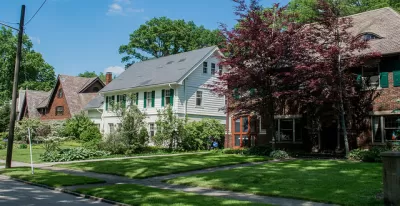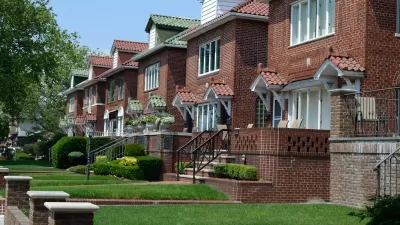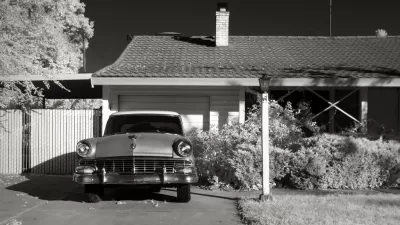The suburbs most likely to prosper are those with wealth and/or walkability.

After reading another article asking whether suburbia has a future, it occurred to me that some suburbs have more of a future than others. But which ones?
To answer this question, let's look at the advantages of suburbs over cities. One set of advantages relates to social homogeneity—that is, a wealthy, well-educated citizenry, which usually leads to low crime and schools with good reputations (because children from privileged backgrounds tend to have high test scores and to avoid violent behavior towards neighbors). Like it or not, well-off people tend to prefer places full of similarly affluent people.
A second set of advantages relate to cost: in high-cost cities, many people escape the high costs of urban housing by moving to cheaper suburbs. Even in low-cost cities like Pittsburgh, people priced out of the most desirable urban neighborhoods might choose suburbs over less expensive (but also more socially troubled) working-class urban places. However, cheap housing alone is not enough to save a high-crime suburb such as Philadelphia's Camden or East St. Louis, Illinois.
Neighborhoods with the first set of advantages are likely to continue to prosper. For example, upper-class suburbs like Pittsburgh's Fox Chapel or Washington's Potomac have low crime and highly rated schools, and because of their social makeup they are likely to retain those advantages. They may be very expensive, but their very expensiveness keeps out the social diversity that might put their advantages at risk. The only possible threat to these suburbs' popularity is a collapse of suburban real estate values so massive that their mansions become affordable to the poor, or perhaps statewide policies that wipe out the economic differences between one suburb and another.
Many middle- and upper-middle-class suburbs and exurbs, such as Atlanta's Alpharetta and Cleveland's Solon, have the same advantages but are significantly cheaper. In the short run, these suburbs are in a strong position: they are cheaper than good city neighborhoods and safer than the not-so-good ones. However, they are at some risk in the long term. If they ever become so affordable that they gain some critical mass of disadvantaged residents, eventually their test scores will start to plummet, and they will lose their appeal to middle- and upper-class families.
For example, Cleveland Heights just east of Cleveland was once a well-off suburb just like Solon. But as its schools became more diverse in the late 20th century, Cleveland Heights became tarred with a reputation as a "bad school district." As a result, Cleveland Heights became less appealing to middle-class families.
However, Cleveland Heights has remade itself to some extent. Even though it lacks the traditional suburban advantages, it does have the advantages of well-off city neighborhoods: walkability, shorter commutes than other suburbs, and crime rates that compare favorably with those of city neighborhoods (though not with many other Cleveland suburbs). As a result, Cleveland Heights has become popular among the sort of people who tend to favor city neighborhoods: singles, empty-nesters, and families who can afford private schools. Thus, even poorer or more diverse suburbs can regenerate by turning into good city neighborhoods.
On the other hand, some suburbs lack both urban advantages and suburban advantages—that is, they lack the urban advantage of short commutes and walkability and the suburban advantages of well-paid residents, low crime, and highly-reputed schools. Even though these suburbs have the suburban advantage of low real estate prices, this advantage rarely outweighs their problems. It seems to me that such suburbs are likely to become poorer over the next few years. For example, Atlanta's Clayton County is not particularly close to downtown, is dominated by car-oriented suburban development, has gone without public transit for several years, is less safe [pdf] than other suburbs, and has a troubled school system. Not surprisingly, Clayton County's household income declined during the 2000s, while some other suburbs became more affluent.
In sum, it seems to me that suburbs with either walkability or wealth are likely to remain stable over the next decade or so—at least as long as they retain these qualities. Suburbs without either are likely to become less prosperous.

Alabama: Trump Terminates Settlements for Black Communities Harmed By Raw Sewage
Trump deemed the landmark civil rights agreement “illegal DEI and environmental justice policy.”

Planetizen Federal Action Tracker
A weekly monitor of how Trump’s orders and actions are impacting planners and planning in America.

How Atlanta Built 7,000 Housing Units in 3 Years
The city’s comprehensive, neighborhood-focused housing strategy focuses on identifying properties and land that can be repurposed for housing and encouraging development in underserved neighborhoods.

In Both Crashes and Crime, Public Transportation is Far Safer than Driving
Contrary to popular assumptions, public transportation has far lower crash and crime rates than automobile travel. For safer communities, improve and encourage transit travel.

Report: Zoning Reforms Should Complement Nashville’s Ambitious Transit Plan
Without reform, restrictive zoning codes will limit the impact of the city’s planned transit expansion and could exclude some of the residents who depend on transit the most.

Judge Orders Release of Frozen IRA, IIJA Funding
The decision is a victory for environmental groups who charged that freezing funds for critical infrastructure and disaster response programs caused “real and irreparable harm” to communities.
Urban Design for Planners 1: Software Tools
This six-course series explores essential urban design concepts using open source software and equips planners with the tools they need to participate fully in the urban design process.
Planning for Universal Design
Learn the tools for implementing Universal Design in planning regulations.
Jessamine County Fiscal Court
Caltrans
Institute for Housing and Urban Development Studies (IHS)
City of Grandview
Harvard GSD Executive Education
Toledo-Lucas County Plan Commissions
Salt Lake City
NYU Wagner Graduate School of Public Service






























